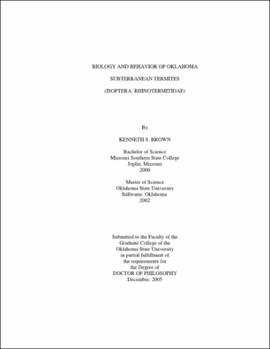| dc.contributor.advisor | Kard, Bradford M. | |
| dc.contributor.author | Brown, Kenneth S. | |
| dc.date.accessioned | 2013-11-26T08:23:43Z | |
| dc.date.available | 2013-11-26T08:23:43Z | |
| dc.date.issued | 2005-12 | |
| dc.identifier.uri | https://hdl.handle.net/11244/6728 | |
| dc.description.abstract | Scope and Method of Study: The objectives of these studies were to investigate the biology and behavior of Oklahoma subterranean termites including colony characteristics in a native tallgrass prairie habitat, soil movement capabilities, and variables affecting cuticular hydrocarbon profiles. A greater understanding of the basic biology and ecology of termites has become increasingly necessary in recent years as control methods have become more targeted. In the first of the three studies, characterizations of three colonies of subterranean termites including foraging population estimates, foraging territory delineations, and caste ratio determinations were conducted on the Nature Conservancy's Tallgrass Prairie Preserve north of Pawhuska, OK. The second study evaluated the soil movement capabilities of two colonies of Reticulitermes flavipes (Kollar) in artificial arenas containing four distinct soil types based on texture. During the final study, preparation techniques for extracting cuticular hydrocarbons from subterranean termites for chemotaxonomic studies were evaluated. Statistical analyses were conducted using PC SAS Version 8.1. | |
| dc.description.abstract | Findings and Conclusions: R. flavipes on the Tallgrass Prairie Preserve were found to forage in areas ranging from 9.0 to 92.3-m2 and contain 10,357 to 183,495 active foragers. Soldiers comprised 2.69 to 4.46% of the total foraging populations. It is concluded that the high termite pressure in this native habitat is likely the result of many small colonies foraging in close proximity to each other. Soil texture significantly influenced both the rate of tunneling and amount of soil removed from foraging tubes over a 4-wk test. Termites tunneled at a significantly faster rate and excavated significantly more soil from foraging tubes packed with higher proportions of sand. Termite hydrocarbon location experiments indicated two distinct sets of hydrocarbons, one that is predominantly internal and one that corresponds to cuticular hydrocarbons. Lipid extracts from termites that were desiccated and/or aspirated prior to extraction contained internal components. Extracts of termites prepared by brush-collection and freezing at -20 degrees C prior to extraction contained no such internal component contamination. It was determined that brush-collecting/freezing specimens prior to extraction yields the most accurate cuticular hydrocarbon profiles and should be the methodology used for termite chemotaxonomic studies. | |
| dc.format | application/pdf | |
| dc.language | en_US | |
| dc.rights | Copyright is held by the author who has granted the Oklahoma State University Library the non-exclusive right to share this material in its institutional repository. Contact Digital Library Services at lib-dls@okstate.edu or 405-744-9161 for the permission policy on the use, reproduction or distribution of this material. | |
| dc.title | Biology and behavior of Oklahoma subterranean termites (Isoptera: Rhinotermitidae) | |
| dc.contributor.committeeMember | Dillwith, Jack W. | |
| dc.contributor.committeeMember | Mulder, Phillip G., Jr. | |
| dc.contributor.committeeMember | Criswell, Jim T. | |
| dc.contributor.committeeMember | Payton, Mark E. | |
| osu.filename | Brown_okstate_0664D_1578.pdf | |
| osu.accesstype | Open Access | |
| dc.type.genre | Dissertation | |
| dc.type.material | Text | |
| thesis.degree.discipline | Entomology | |
| thesis.degree.grantor | Oklahoma State University | |
